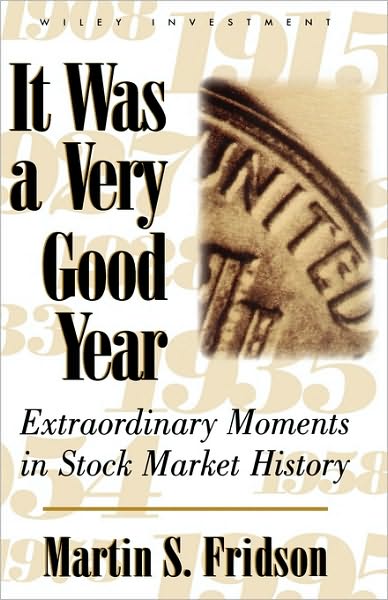Trivia question: think of the US stock market from 1900 to 1997.? Now think about the top 10 years in terms returns during that period.? Call those years? “Very good years.”? What decade had the most of those very good years?
If you’re not a fan of market history, you might be inclined to think that the 80s or 90s would be the top decade by that measure.? Perhaps some with a little bit of market history would think the 20s were the top by that measure.? But the answer is a three-way tie between the 20s, 30s, and the 50s.? The 20s had 1927 and 1928, the only pair of back-to-back very good years, fueled by the credit expansion that ended in the Great Depression.? And in the midst of the Great Depression, there were horrendous years of loss in the market and years of amazing gains.? Two years amazing gains were 1933 and 1935, 1933 being the best of all years for the century as far as market returns go.? And that was in the midst of the worst decade for market performance in the 20th Century, which would only be eclipsed by the the first decade of the 21st Century.
The 50s had 1954 and 1958.? A decade of relative calm led to some spectacular gains in the market.
Second trivia question: what decades didn’t have any “very good years?”? The answer there would be the 40s, the 60s, and the 80s.? Now with World War II, one could understand why there weren’t any very good years in the 40s.? There were the costs of fighting the war, relative scarcity of consumer goods at home, postwar inflation, and the degree of fear restrained nonmilitary economic activity.
But the 60s and 80s?? Those were good decades for stocks.? How come there were no very good years during those decades?
Take a look at this interactive graphic from the Wall Street Journal.? Very good decades do not always include very good years.? Both the 60s and 80s were long expansions that did not have a lot of macroeconomic volatility.? Okay, the 80s did have a lot of macroeconomic volatility at the start and at the end, but in general it was a period of falling interest rates, and thus it had some good years but no very good years.
One of the goals of the book is to answer the question: when do you tend to get a very good year?? The author comes to the answer that you tend to get a very good year after there are economic problems leading to depressed valuations, followed by loose monetary policy, leading to an expansion in credit.
I liked this book a lot.? I thought it was a lot of fun because he doesn’t just dwell on the markets but goes into the nature of business during each very good year.? What were the hot trends?? What was going on in terms of social trends? ?What were the crises that were gripping the world?? What were politicians saying and doing?
In this book you don’t get a dry textbook that aims only to prove the thesis.? You get taken on a journey through nooks and crannies of American history of the 20th century, which gives you some of the social and political flavor of what it’s like when it is a very good year.
Now, maybe someday I’ll get to write a book.? One of the books that I would like to write would be the sister to this book: It was a very bad year.? I would be interested in your comments on the matter, because I think would be equally fascinating book.? And, are Americans more fascinated by success or failure?? I don’t have a good answer to that one, because I see books in the business and finance sections that cover both.
And so I give this book a hearty commendation.? It is well-written.? It has a good concept.? It is thorough, though light at a mere 220 to 230 pages.
Who would benefit from this book:
Any investor would benefit from this book.? Good years in the stock market are not random, but tend to follow bad years, and have the Federal Reserve running a loose monetary policy.
If you want to, you can buy it here: It Was a Very Good Year: Extraordinary Moments in Stock Market History (Wiley Investment).
Full disclosure: I bought this book with my own money.
If you enter Amazon through my site, and you buy anything, I get a small commission.? This is my main source of blog revenue.? I prefer this to a ?tip jar? because I want you to get something you want, rather than merely giving me a tip.? Book reviews take time, particularly with the reading, which most book reviewers don?t do in full, and I typically do. (When I don?t, I mention that I scanned the book.? Also, I never use the data that the PR flacks send out.)
Most people buying at Amazon do not enter via a referring website.? Thus Amazon builds an extra 1-3% into the prices to all buyers to compensate for the commissions given to the minority that come through referring sites.? Whether you buy at Amazon directly or enter via my site, your prices don?t change.

